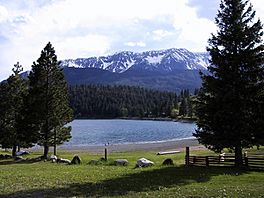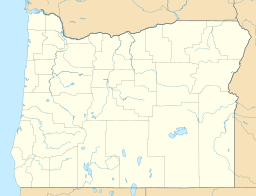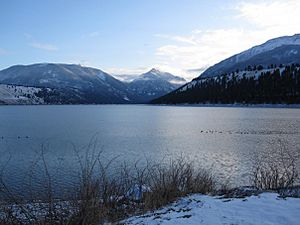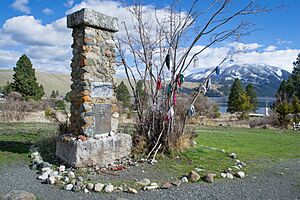Wallowa Lake facts for kids
Quick facts for kids Wallowa Lake |
|
|---|---|

Wallowa Lake with the Wallowa Mountains in the background
|
|
| Location | Wallowa County, Oregon |
| Coordinates | 45°18′32″N 117°12′38″W / 45.30889°N 117.21056°W |
| Type | Natural, oligotrophic, with dam |
| Primary inflows | Wallowa River |
| Primary outflows | Wallowa River |
| Catchment area | 51 square miles (130 km2) |
| Basin countries | United States |
| Max. length | 3.5 miles (5.6 km) |
| Max. width | 0.75 miles (1.21 km) |
| Surface area | 1,508 acres (610 ha) |
| Average depth | 161 feet (49 m) |
| Max. depth | 299 feet (91 m) |
| Water volume | 243,500 acre-feet (300,400,000 m3) |
| Residence time | 2.5 years |
| Shore length1 | 8.2 miles (13.2 km) |
| Surface elevation | 4,372 ft (1,333 m) |
| Settlements | Joseph |
| 1 Shore length is not a well-defined measure. | |
Wallowa Lake is a long, narrow lake shaped like a ribbon. It is located about 1 mile (1.6 km) south of Joseph, Oregon, in the United States. The lake sits high up, at an elevation of 4,372 ft (1,333 m).
This beautiful lake was formed by huge, ancient ice sheets called Pleistocene glaciers. These glaciers left behind large piles of rock and dirt, called moraines, which now act like natural dams. At the southern end of the lake, there's a small community with vacation homes, places to stay, restaurants, and other small shops. People have been coming to Wallowa Lake for fun and relaxation since at least the 1880s. You can also find the Wallowa Lake State Park at the very southern tip of the lake.
Contents
How Wallowa Lake Was Formed
Wallowa Lake is a great example of a lake created by natural dams called moraines. These moraines are like giant walls of earth and rock. They start deep under the water and rise more than 900 ft (270 m) above the lake's surface.
Before the moraines were fully formed, a large fan-shaped area of dirt and rocks was in the valley. This was brought in by the Wallowa River. Then, a series of huge ice sheets, called glaciers, moved into the valley. They pushed all this dirt and rock, and also dug deep into the ground, creating the lake basin.
Scientists believe that about eight or nine glaciers helped build these walls that now hold the lake. The last big glacier, known as the Wallowa Glacier, moved through the valley around 17,000 years ago. Its moraines make up much of the lake's shoreline today. Even after Wallowa Lake formed, other glaciers appeared high in the nearby mountains, but they didn't reach the lake itself.
History of Wallowa Lake
The Nez Perce People and Early Conflicts
The land around Wallowa Lake was originally home to the Wallowa band of the Nez Perce tribe. In 1855, a treaty was signed that protected this area for the Nez Perce. However, when gold was discovered nearby, many miners and settlers started coming into the area.
This led to new discussions in 1863. American agents wanted to make the Nez Perce reservation smaller and remove Wallowa County from it. The Wallowa Nez Perce leaders refused to sign this new treaty. But other Nez Perce leaders, whose lands were not affected, did sign it. This meant the Wallowa band was suddenly outside the reservation.
By 1877, tensions grew between the settlers and the Nez Perce. This led to conflict. Rather than accept the new rules, Young Joseph, a leader of the Wallowa band, led his people away from their homeland. After a difficult war, the U.S. Government took the land, allowing more settlers to move in. This led to the creation of many towns we see today.
On October 5, 1877, Chief Joseph gave a famous speech when he surrendered. He spoke about being tired of fighting and wanting to find his people. After the surrender, Chief Joseph and the Nez Perce were forced to leave the area. Today, there are many memorials around the lake and in nearby towns to remember the Nez Perce tribe and their history. In 1880, the town closest to Wallowa Lake was named Joseph in honor of Chief Joseph.
Growth of Tourism at Wallowa Lake
The first businesses near Wallowa Lake started in the town of Joseph. In 1879, Matthew Johnson opened the first store. Because many gold miners were in the area, the store did very well, and Joseph began to grow. The area became so busy that Wallowa County was officially formed in 1887, including the lake and its towns.
Wallowa Lake became popular not just with miners, but also with tourists. People saw a chance to create fun places for visitors. One of the first big attractions was the Wonderland Inn, which is now called the Wallowa Lake Lodge.
The Wonderland Inn was built in 1923 as a fun park at the south end of the lake. It had a restaurant, a store, a bowling alley, a dance hall, an outdoor movie theater, and even a carousel pulled by horses! There were also cabins for people who wanted to stay overnight. Guests arriving in Joseph (at the north end of the lake) could take an 18-passenger boat all the way down the lake to the park.
The amusement park operated until 1940. A very harsh winter brought so much snow that most of the buildings were crushed, and the park had to close. However, the main inn survived and is still open today as the Wallowa Lake Lodge. Over the years, more stores, lodges, restaurants, and rental cabins were built at the south end of the lake, making it a popular tourist spot.
Many of the businesses at the south end of Wallowa Lake work together in a group that helps promote tourism and solve community issues. During the summer, about 2,000 to 3,000 people live at the south end of the lake, and all the businesses are open. But from October to March, fewer than 40 people live there year-round, and only a few places stay open.
The Wallowa Lake Dam
At the northern end of Wallowa Lake, near Joseph, there is a dam. It was first built in 1918 by a private company to help with irrigation, which means providing water for farms. In 1929, it was made stronger with concrete and raised to 35-foot (11 m) high. This dam does not create electricity. It is owned and managed by a local group of farmers who use the water for irrigation.
In 1996, government groups found that the old dam needed repairs to be safer. In 2006, money was set aside to fix it. The repairs might also include a way for fish, like coho and sockeye salmon, to swim past the dam.
Wallowa Lake Tramway
Near the lake, there's a special cable car system called an aerial gondola lift. It takes people from the valley floor all the way to the top of Mount Howard, which is about 8,000 ft (2,400 m) high. It was built in 1968 and opened to visitors in 1970. From the tram car, you can see amazing views of Wallowa Lake and the mountains around it.
In June 1992, there was a problem with the tram's system, and everyone had to be safely taken off by helicopter. No one was hurt, and this has been the only major issue with the Tramway since it opened.






